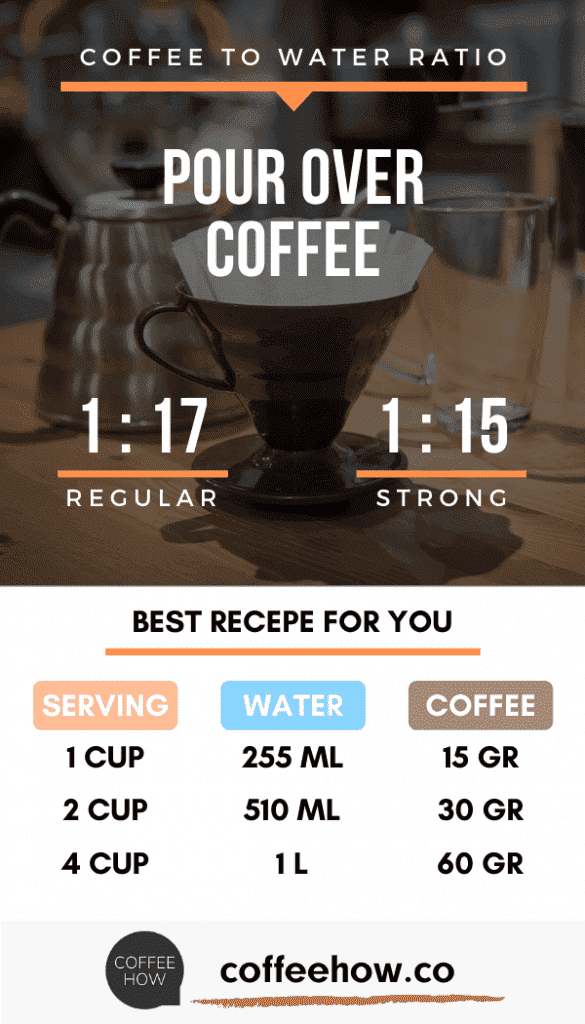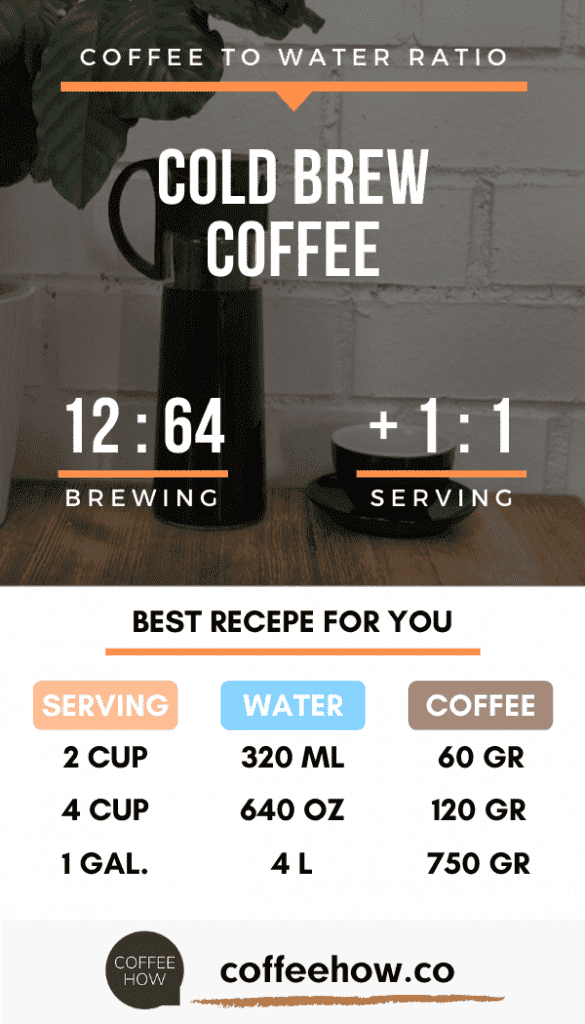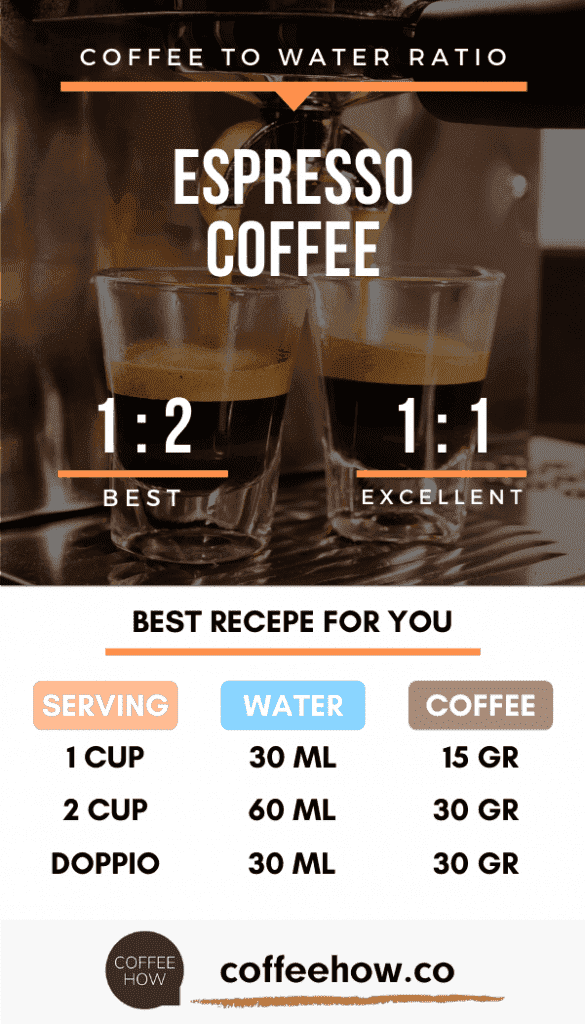Many of us start our day with a much needed cup of coffee. We watch…
When coffee tastes right, it is a joy to drink. The smell of the brew, the first taste to hit your tongue, and the aftertaste of nut and bitter make for a delightful treat.
But sometimes, the coffee you make seems to be missing something. Maybe it’s too strong and punches you with an overwhelming flavor, or maybe it is too weak and doesn’t deliver the sensation you were expecting at all.
But there’s no reason to leave this up to chance, wondering “how much coffee per cup?”.
Take charge of your coffee experience with the right water to coffee ratio.
Some might wonder what the importance is of using a brew ratio. After all, in the morning, I just want to make my cup of joe and get the day started. But using the correct coffee grounds to water ratio is important for making sure you are getting the very best flavor out of your particular coffee beans.

Let’s talk about specifics. When making a fantastic cup of coffee, it’s important to use exact measurements.
To measure your water, you’ll want to use a scale and weigh your pours in exact amounts. Exact measurements are key here when looking at the coffee grounds to water ratio. Measuring water by volume can be tricky. Brewers must keep an eye on the meniscus and look at their measuring cup as it sits on a level surface. Even so, a digital scale is more accurate.
Many of us are used to measuring out coffee beans using a scoop. However, this is not the most accurate way to achieve the perfect coffee grounds to water ratio. You should weigh your ground beans using a digital scale.
Although it is slightly quicker to simply scoop out your coffee using a measure, you will lose accuracy and find that the coffee you make is not set at the coffee to water ratio you intended to make. By asking how many tablespoons of coffee per cup, instead of how many grams, your ratios will not be correct. The same is true for your water; in the end, a digital scale is simply more precise.
Digital scales are an essential tool for making sure your coffee to water ratio grams are correct.
There are approximately five grams of coffee per tablespoon. The issue with measuring by volume in this way is that depending on your grind size, the amount of granules that will fit in a tablespoon will vary.
If your beans have been ground very fine, you will fit a higher weight of beans into your tablespoon. If your beans are coarsely ground, you will fit fewer beans into the tablespoon measure.
Thus, your measurement will be more exact with a digital scale when you are trying to measure your grams of coffee per cup, as opposed to measuring how many tablespoons of coffee per cup.

We’ve discussed the best ways to measure our water and coffee, but now let’s talk about the best ratio between the two.
It’s important to note that there is not a one-size-fits-all ratio that can be applied to every type of coffee.
After all, the brew method, grind, and other factors can alter the coffee such that different ratios are needed.
Additionally, the strength of your coffee will be impacted by the grams of coffee per cup you use. Use more concentrated ratios for stronger brews, and less concentrated ratios for less strong brews.
When using a French Press or AeroPress, your beans will be immersed in your water for the entire time the brewing process occurs. Thus, a 1:15 ratio of coffee to water is best suited for this method for a medium strength cup of coffee.
What does this mean?
You will want one part of coffee for every 15 parts of water.

Your pour over coffee ratio should be 1:17. Be sure to utilize a quality filter, and make sure you’re using clean water. Heat the water, pour over the grounds, and wait for your coffee.

“Drip coffee” refers to coffee that is brewed in your coffee pot. Typically this involves a filter and water.
Drip coffee is the method that most people think of when they consider a cup of coffee. This method has a few benefits: it is fast to make, and it is easy. Simply load up your water and coffee grounds, and you are ready to go!
When making coffee in your coffee pot, the best drip coffee ratio to follow is 1:15. Using precisely measured grams of coffee per cup is key to a fantastic drip coffee.

Cold brew is not the same as an iced coffee. Typically an iced coffee is a drink that has been made with heated water that is later cooled.
With cold brew, the coffee is actually brewed using cold water. For cold brew made by immersion, the coffee sits directly in the water source for a few hours. After that, the coffee grounds are strained out, leaving a mellow cup of joe behind.
The best coffee to water ratio grams to use when making cold brew coffee is 12:64. Then when the coffee is ready to drink, cut the beverage with 1:1 water (or cream).

Some coffee connoisseurs wonder if a cold brew brings out the complex and acidic flavors provided by your particular beans. Others have more complicated solutions to this issue that may require the use of specialized equipment in the brewing process. However, cold brew is a delicious option– particularly in the warm summer months where a hot cup of coffee is not as desirable.
For espresso, the best coffee to water amount to use is 1:2. You’ll want to consider the flavor profile you are going for, and do some taste testing to adjust based on your particular tastes.
For example, if you’d like a sweet flavor with some acidity, or if you prefer a more acidic and less sweet brew, adjust your ratios accordingly. It is possible to make excellent espresso with a 1:1 ratio, depending on the outcome you have in mind. Experimentation will yield optimal results– particularly if you are taking notes as you compare your brews. Have fun with this process, and develop your palette as you go along.

Water
Enter the Desired amount of Water (in ML): 100
▮
▮
▮
▮
▮
▮
▮
▮
▮
▮
▮
▮
▮
▮
▮
▮
▮
▮
▮
100
200
300
400
500
600
700
800
900
1000
Brewing Method
Chosen Method: French Press
Strength
Coffee: GR
These ratios may seem like a lot of math. But keep in mind, we are only talking about simple fractions.
For example, you will want one part coffee for every two parts espresso, or one part coffee for every fifteen parts water for drip coffee.
If you planned to make a drip cup of coffee, and you wanted to use 23 grams of coffee, you would use 345 grams of water to make your drink. This is because 23 multiplied by 15 is 345. One part, 23 grams, multiplied by 15, is 345 grams.

Coffee ratios are so important that the Specialty Coffee Association has put out a standard “Golden Cup” reference guide.
This guide states that any coffee should be brewed with a 1:18 ratio, plus or minus 10%.
This gives brewers with individual preferences the ability to start from a known coffee range and play with their brew quality without making a fantastically strong or unappealing weak brew.
Highly concentrated brews will yield a stronger cup of coffee. But this should not be conflated with roast darkness. Darker roasted coffee beans may carry a more bitter taste, but that does not mean that they will produce a stronger cup of coffee. After all, dark coffee beans can be made into coffee diluted at 1:25, which would be a weak cup indeed. In short, strength is determined by the amount of dissolved coffee grounds in the water.
During the brewing process, various flavors are extracted from the coffee grounds. These flavors include sweet and sour, bitterness, and viscosity. These compounds are water-soluble, meaning that they dissolve in water. This is exactly what we want when we are brewing coffee.
Getting the right coffee to water ratio is key to making sure the extraction process pulls out the flavors you want from the beans you have selected. There are a lot of variables to this process, but one key is to pay close attention to the brews you create and watch for the flavor characteristics you prefer. This is a learning process for all brewers, but it can also be a lot of fun!
TDS stands for “total dissolved solids". This measurement is another piece of information that helps brewers create the perfect cup of coffee.
Your coffee should have a TDS range of 18-22%. This information can help brewers analyze problems with their brewing equipment and methods as they search for the perfect tasting cup.
Use a refractometer to determine the TDS measurement for your coffee. This device can provide a scientific approach to the brewing process, but the best measure is still the old taste test. What flavors are you picking up? What is the mouth feel experience? What notes would you like to see more of? Answering these questions should help improve your coffee and your brewing skills.
Hopefully you’ve learned a few things about the importance of measurement, precision, and attention to detail as you perfect your coffee.
Answering the question, “how much coffee per cup?” provides the opportunity for brewers to play with flavors and brewing methods to extract flavors out of the coffee beans they choose.
In short: making coffee is a creative and skilled practice, so have fun and happy brewing!
